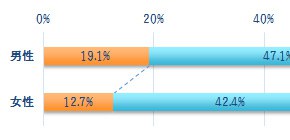
A sign of change of social awareness in Japanese people shown
The latest results from the 2015 Stratification and Social Psychology (SSP) Project Survey
Abstract
A group of researchers led by KIKKAWA Toru (Professor, Graduate School of Human Science, Osaka University), elucidated on a quantitative basis social changes over time and the mind of Japanese people exemplified in changes in the awareness of young people; such as positive participation in child-rearing ( Ikumen attitude) and avoiding study abroad (introversive orientation.) With respect to the realization of the Prime Minister’s Shinzo Abe’s slogan "Society Promoting Dynamic Engagement of All Citizens , " these research findings make it possible to decipher from data where the differences in levels of interest in the nation’s consciousness lie and what the real issues are.
Research Background
Academic social surveys differ from mass media public opinion surveys in terms of the level of accuracy of their subject design and survey methods and their abundance of question items and information about respondents’ profiles. They therefore cost much more in terms of expense and time, and as a result they are not conducted frequently. However, grasping the correspondence between the change in Japan’s social structure over time and the transformation of the “social consciousness” of the Japanese people requires large-scale data and a high level of analytical technique; thus can only be done through an academic social survey.
In such works, a critical issue we faced was the difficulty in grasping trends among the youth generation. This is because the generation of people under thirty, in other words those born after 1980s, represent a minority in the population pyramid and also because there are many instances of survey participation refusal and absences. Nevertheless, grasping the mind of the young generation that are actively working and supporting society allows us to know the latent social traits, say software of the society, in advance the future trend of Japanese society.
For the present survey, a group of approximately fifty empirical sociologists led by Professor Kikkawa were organized as “The SSP Project (Stratification and Social Psychology Project).” It newly launched in 2011 as a comprehensive research organization dedicated to empirical study of the relationship between stratification (higher and lower social positions) and social psychology (perspectives and ways of thinking). This project has been conducted with the support of a KAKENHI (Grant-in-Aid for Scientific Research) grant in Basic Research (S) from the Japan Society for the Promotion of Science. After several preliminary investigations and analysis was performed, a compilation of “the 1st SSP Survey” (Nationwide Interview Survey into Social Psychology) was recently conducted. In this survey, comparability of data was maintained in 25-year intervals with the SSM 1995 Survey and a design was implemented to capture the most recent social psychology.
Details of the 1st SSP Survey (SSP2015):
- ・ 3,575 valid responses (response rate 43.0%)
- ・ The subjects were men and women between the ages of 20 and 64 (born between 1950~1994). We intended to omit the “baby boom generation” ( dankai no sedai ) from the subject range and placed emphasis upon the young working generation now facing issues such as work, family, education, and consumption.
- ・ Question content was made up of approximately 56 items on social psychology variables and approximately 35 items on individual profile variables (academic pedigree/occupation/economic power).
- ・ 24 items were psychological items designed in comparison with a survey from 1995. 32 items are newly designed items looking at new trends.
- ・ This research adopts an originally developed computer assisted personal interview method with tablet PC (a world-first). Because this makes it possible to instantly convert on-the-spot survey responses into data, there are far fewer human errors and invalid responses than in analog tabulation and thus the time spent on tabulation was greatly reduced.
Outline of Research Findings
Rather than report survey data in tabulated form, we released the simple results of multivariate analysis into the connection between social mechanisms such as gender, generation, academic pedigree, income and occupation and the psychological state of people today and indicated an outlook for current Japanese society.
The findings we released cover a broad range of issues including family, gender, education, consumption and inequality, but we shall enumerate a part of these below.
- ・Unexpectedly, participation in house chores and child-rearing is positively accepted by more men than women. (Figure 1)
- ・More respondents in their 20s and 30s have a negative opinion about study abroad than the middle-aged group. (Figure 2) The former do not think their contributions at work are being recognized (Figure 3) and their concern over competition is greater than that of their counterparts of 20 years ago. (Figure 4)
- ・College graduates, white collar workers, and high-income households tend to affirm neo-liberal competitive society, but those at the opposite end of the spectrum feel their weakness against economic risk, have expectations from welfare, and are equality-oriented.
- ・One's social position begins to affect how one feels the disparity in society and each individual way of viewing unequal society. The response by Japanese people in 2015 to differences in academic status, occupation, and income were 1.5 times more sensitive than in 1995.
In this way, surveys on how the daily life of modern Japanese people affects their way of viewing things and thinking (social consciousness), especially through the examining of the relationship between social position (stratification) and Japanese people’s social mind, will clarify how this unequal Japanese society will move forward.

Figure 1. It is common sense for a husband to do as much housework and child-rearing as his wife.

Figure 2. Children should study abroad as much as possible.

Figure 3. My contribution is fairly admitted in the workplace

Figure 4. To the extent that opportunities are equally available, we must accept the disparity in wealth that results from competition.
Related links
- Empirical Sociology, Graduate School of Human Sciences, Osaka University (link in Japanese)

